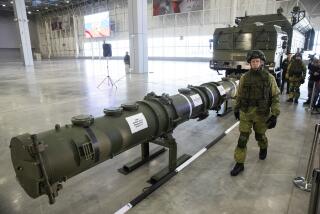A Step Forward on Arms Control : Accord Would Mean More Politically Than Militarily
Seven years of fitful negotiations may finally have brought the United States and the Soviet Union to the brink of concluding an agreement to limit intermediate-range nuclear forces. Even though the Soviets have accepted the “zero option” first proposed by the United States and will be dismantling many more warheads than the United States, the prospect of an agreement has aroused anguish in Helmut Kohl’s West German government, opposition from Reps. Jack Kemp (R-N.Y.) and Les Aspin (D-Wis.) and the Olympian criticism of Richard M. Nixon and Henry A. Kissinger.
Amid the clamor of contending voices, six points should be kept in mind.
An INF agreement will not mean the denuclearization of Europe. Under terms of the zero option, the United States would have to remove its 208 ground-launched cruise missiles and 108 Pershing 2 ballistic missiles from European soil. That would still leave more than 4,000 U.S. nuclear warheads in place, not to mention those of the British and French or on U.S. carriers offshore. Even if the 1,000 or more battlefield nuclear weapons were removed, more than 2,000 U.S. nuclear weapons would remain. As if that were not enough, the North Atlantic Treaty Organization is considering whether to add new missiles and bombs to its nuclear arsenal.
An INF agreement will not decouple Western Europe from U.S. protection. The ties that bind America to Europe are those of interest and sentiment, not the physical presence of U.S. nuclear weapons. The site from which U.S. nuclear strikes would be launched against the Soviet Union would hardly affect calculations in the Kremlin or the White House about whether an American President would be willing to risk retaliation against the United States for the first use of nuclear weapons on Europe’s behalf--”coupling,” in NATO parlance.
An INF agreement will not affect the military balance. What deters a deliberate attack on Western Europe continues to be the conventional balance of power, which is not nearly as one-sided as the Pentagon likes to pretend, plus the risk of escalation to nuclear war. The elimination of INF warheads from Europe does not change that. Even if all 1,500 INF warheads now deployed in Europe are removed, it will reduce the nuclear arsenals of the superpowers by less than 3%.
An INF agreement would make a modest but useful contribution to military stability. It is the threat of war, not the number of weapons, that arms control above all seeks to reduce. Thus stability, not reduction, is the ultimate test of any agreement. By that standard, the zero option does not diminish the deterrence of premeditated war. And it somewhat reduces the risk of inadvertent war in a crisis by eliminating the Pershing 2, which--by virtue of its range, accuracy and short flight time--can attack Soviet command and control facilities in a matter of minutes. That gives the Soviets an incentive to preempt in a crisis, which puts both sides at risk of becoming embroiled in a nuclear war that neither sought. For stability to be greatly enhanced, the superpowers would have to agree to reduce their strategic nuclear weapons, not just INF.
An INF agreement will be truly meaningful if it leads the way to other, more far-reaching, arms-control measures. The draft INF treaty is based on a rather simple concept: Eliminate a class of weapons defined by range (300 to 3,300 miles) and characteristics (land-based missiles). Nuclear weapons with ranges below 300 miles or above 3,300 would not be covered by an INF accord. Nor would those based at sea or launched or dropped from bombers. An INF accord would thus be both lonely and exposed. If subsequent agreements limiting strategic weapons and conventional forces are not reached in due time, inevitable quantitative and qualitative developments will undercut the value and jeopardize the viability of an INF accord--especially so in view of the Administration’s repudiation of SALT I and SALT II, a repudiation that leaves no limits on strategic nuclear forces.
An INF agreement could be a significant political achievement. The accord could compensate with political punch for what it lacks in military meaning. It would oblige an Administration, avowedly hostile to any arms control, to defend a bilateral security arrangement with the Soviet Union before Congress and the people. That would make it more difficult for the Administration to proceed unilaterally with programs, like the premature deployment of a primitive SDI, that do nothing for U.S. security and jeopardize the very framework required for future arms-control agreements.
An INF accord could point the way to further advances on the arms-control front. Agreement on the outline of a more comprehensive accord controlling strategic offensive forces and SDI is still possible, provided the United States is prepared to scale back its intention to develop and deploy strategic defenses. The framework could be concluded by a summit meeting this fall, with the details to be negotiated in 1988 and ratification to await a new Administration. That would be an arms-control achievement worthy of strong bipartisan support. And it would earn President Reagan a bright place in history.
More to Read
Sign up for Essential California
The most important California stories and recommendations in your inbox every morning.
You may occasionally receive promotional content from the Los Angeles Times.










